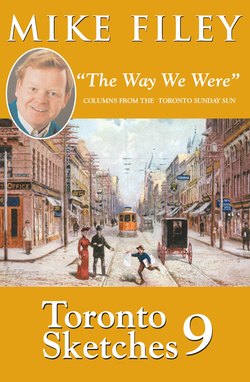Читать книгу Toronto Sketches 9 - Mike Filey - Страница 18
На сайте Литреса книга снята с продажи.
ОглавлениеOn the Tube
Stretching 4.6 miles from the southern terminus at Union Station northward to Eglinton Avenue, with 10 stations in between, Toronto’s first subway line opened in 1954. It came as a welcome relief for many of the city’s 700,000 citizens who had often suffered excruciatingly long waits for the lumbering surface streetcars. Today Toronto has a trio of subway lines, totalling 23.9 miles in length and serving 69 stations.
Interestingly, the need for some sort of rapid transit on, over, or under the city’s main street was recognized in the early years of the 20th century. First, there was talk of an elevated railway, followed in 1910 by a proposal for a “tube” (a turn-of-the-century term for subway). This latter idea was even put forward on the 1912 civic election ballot. Championed by mayoral candidate Controller Horatio Hocken (Hocken Avenue), the plan had “tubes” operating under Bay and Terauley streets (the latter the extension of Bay north of Queen), then northeast under what is now Ramsden Park to continue north under Yonge to a terminal at St. Clair Avenue. Both Mr. Hocken and his imaginative, if premature, “tube” proposal were defeated. In a strange twist of municipal job shuffling, the far-sighted Hocken would serve as chief magistrate, anyway, when the man who actually won the job as mayor (Reginald Geary, Geary Avenue) decided mid-term that he would prefer the position of city solicitor. Hocken was appointed mayor for the remainder of 1912 and then formally elected by the people to serve again in 1913.
The Yonge Street subway proposal then lay dormant for almost two decades until the malaise of the Great Depression prompted a series of ideas to get men back to work. One of these ideas involved the construction of what was called a “streetcar subway.” This concept would see 3,000 men dig a 20-foot-wide trench down the middle of Yonge Street at the bottom of which track would be laid over which ordinary streetcars would operate. Bridges would carry cross streets over the trench while pedestrians would be accommodated on street-level sidewalks on either side of the trench. Needless to say, nothing ever came of this plan.
With the outbreak of the Second World War in 1939, Canadians put other things out of their collective minds and quickly rushed to help England. Suddenly, there were more important issues than solving the Yonge Street traffic problem. Nevertheless, the Toronto Transportation Commission (later renamed the Toronto Transit Commission) was convinced that downtown traffic congestion would become a major problem in postwar Toronto. In addition to ensuring efficient day-to-day operations at this crucial period in the nation’s history, TTC officials and staff continued to seek possible solutions to the inevitable transit problems facing Toronto in the future.
Under the watchful eye of TTC Inspector Findlay McLeod, Chairman William McBrien takes the controls of the first Yonge subway train on March 30, 1954. McBrien passed away less than three months after this photo was taken. (Telegram photo from the Toronto Sun Archives)
An obvious solution was to free up Yonge Street by removing the streetcars and building that elusive subway. One of the most enthusiastic subway advocates was William Carson McBrien, the chairman of the Toronto Transportation Commission. McBrien, who was born on a farm near Orangeville, Ontario, in 1899, came to Toronto with his family in 1902 and attended Gladstone (now Alexander Muir) and Dovercourt public schools.
The TTC’s McBrien Building looms over one of the original Yonge subway trains. Today two of the cars are on view at the Halton County Radial Railway Museum near Rockwood, Ontario. See www.hcrr.org. (Courtesy Ted Wickson & JBC Visuals)
One of McBrien’s first jobs was that of “call boy” on the floor of the Toronto Stock Exchange. A few years later, having amassed cash assets of $125, he and an older brother opened a hardware store on Bloor Street West. Then, when war was declared on Germany and its allies in 1914, McBrien, like thousands of other young Canadians, joined up and served as a lieutenant in the 95th Battalion and later (and rather fittingly as it would turn out) as a major with the 10th Battalion Canadian Railway Troops. Returning after the war, McBrien served his city first as a member of the Board of Education and then from 1926 to 1929 as a Toronto Harbour commissioner. In 1930 McBrien’s municipal and military experience resulted in City Council appointing the young man as a commissioner of the nine-year-old Toronto Transportation Commission. Three years later McBrien was appointed chairman, an influential position that allowed him to pursue his dream of a Yonge Street subway with additional vigour.
McBrien’s dream began to take shape officially on September 8, 1949, when work commenced at the Yonge and Wellington intersection. Exactly four years, six months, and 25 days later Toronto’s first subway opened. In the interim, however, McBrien became terminally ill. Nevertheless, he had the tenacity not only to attend the inaugural ceremonies but to help drive the first train out of the new Davisville station. Less than three months later William Carson McBrien was dead.
In 1958, to honour this remarkable Torontonian, the TTC’s new head office situated over the Davisville station at Yonge Street and Chaplin Crescent was officially named the McBrien Building.
April 6, 2003
